内容
利便性と持続可能性が両立するペースの速い現代社会では、折りたたみ式ウォーターボトルの人気が急上昇している。この革新的な容器は場所を取らないだけでなく、環境にも優しい。しかし、衛生状態を保ち、寿命を延ばすためには、適切な手入れ、特に乾燥が欠かせない。この記事では、大量注文に対応し、製品の品質を維持するために専門家の指導を必要とする卸売業者向けに、折りたたみ式水筒を乾燥させるための最も効果的なテクニックを掘り下げる。
![]()
![]()
乾燥の重要性 折りたたみ式シリコーン水ボトル
折りたたみ式ウォーターボトルの内部にこもった湿気は、細菌の繁殖、カビ、不快な臭いの原因となります。適切に乾燥させることで、内部も外部も清潔でフレッシュな状態を保つことができ、繰り返し使用する上で非常に重要です。卸売業にとって、このステップは、顧客に提供する商品の使いやすさや魅力に直接影響するため、非常に重要です。
![]()
![]()
折りたたみ式水筒の正しい選び方
卸売りのための注文の折りたたみ可能な水のびんを選ぶとき材料および設計を考慮しなさい。一流のシリコーンの工場として、私達は良質、食糧等級、適用範囲が広く、耐久のシリコーンを使用することの重要性を強調する。当社のカスタマイズオプションは、ブランディングとパーソナライズを可能にし、当社の製品は市場で際立っている。これらの側面に焦点を当てることによって、我々はボトルが機能的であり、私たちの卸売パートナーの特定のニーズを満たすことを保証します。
乾燥のステップ・バイ・ステップ・ガイド
1.空にして十分にすすぐ:
使用後は、折りたたみ式ウォーターボトルを空にして、ぬるま湯でよくすすいでください。必要に応じて、中性石鹸とボトルブラシを使い、残留物や汚れを落とします。すすぎ洗いをすることで、残った液体や洗浄剤が取り除かれ、ボトルの乾燥工程に備えます。
2.余分な水を振り出す:
水洗いしたら、折りたたみ式ウォーターボトルを激しく振って、できるだけ水分を取り除く。この最初のステップにより、内部に残る水分の量が減り、全体的な乾燥時間が短縮される。
![]()
![]()
3.ボトルを完全に広げる:
折りたたみ式水筒が完全に膨らんでいることを確認する。こうすることで、内部のすべての面が空気に触れ、より効率的に蒸発しやすくなります。ボトルが完全に開いていると、空気の流れがよくなり、素早く完全に乾かすことができます。
4.開けた場所で自然乾燥させる:
折りたたみ水筒を逆さまにして、清潔で乾いた場所に置き、自然乾燥させます。紫外線は時間とともにシリコンを劣化させるので、直射日光の当たらない風通しの良い場所を選んでください。自然乾燥は最もやさしい方法で、ボトルの完全性を保ちます。
![]()
![]()
5.清潔なタオルを使うと乾きが早い:
折りたたんだ水筒を早く乾かしたい場合は、専用のボトルブラシでボトルに残った水分を拭き取ってください。特に柄やロゴが印刷されている場合は、表面に傷をつけないように注意してください。この手作業による乾燥の後、風乾を行い、すべての部分が完全に乾いていることを確認します。
6.涼しく乾燥した場所に保管する:
折りたたみ水筒が完全に乾いたら、次に使用するまで涼しく乾燥した場所に保管してください。湿気の多い場所での保管は避けてください。湿気がこもり、ボトルの清潔さが損なわれる恐れがあります。
品質維持の秘訣
折りたたみ式シリコーン水筒の寿命と衛生面をさらに向上させるには、以下のヒントを参考にしてください:
- ボトルに摩耗や損傷の兆候がないか、定期的に点検してください。
- 洗浄の際は、研磨剤入りのスポンジや刺激の強い薬品の使用は避けてください。
- 湿気を防ぐため、使用しないときはキャップを外して保管する。
- 購入した商品を最大限に活用してもらうために、顧客にお手入れ方法を説明することも検討しましょう。
折りたたみ式シリコーン水筒を適切に乾燥させることは、その清潔さを維持し、寿命を延ばすためのシンプルかつ重要なステップです。説明したステップに従うことによって、ユーザーは折りたたみ可能な水筒が最高の状態に保たれることを保証することができます。



